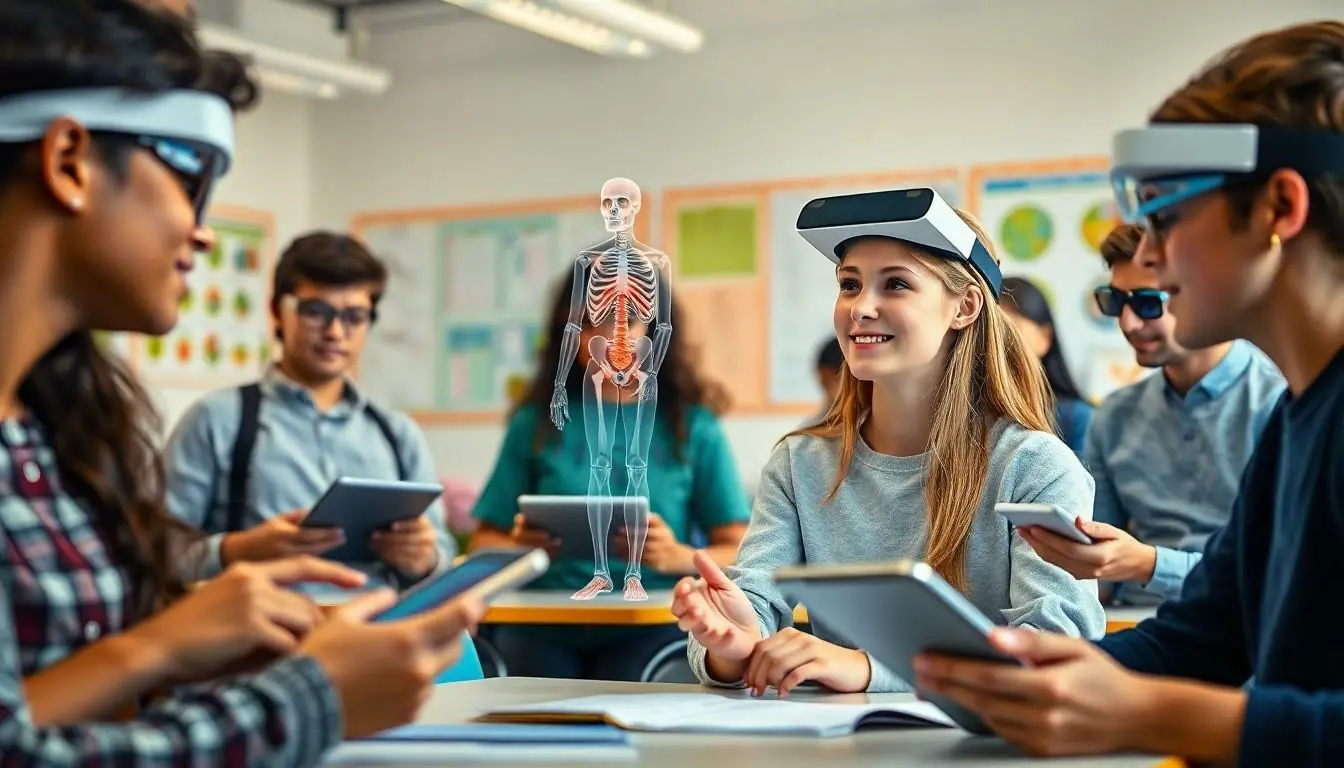Imagine walking through your living room and suddenly encountering a life-sized dinosaur lounging on your couch. Sounds like a scene from a sci-fi movie, right? Welcome to the world of the AR effect, where the line between reality and imagination blurs in the most entertaining way. This cutting-edge technology is transforming how people interact with their surroundings, turning mundane moments into extraordinary experiences.
From enhancing gaming adventures to revolutionizing shopping, the AR effect is everywhere, and it’s not just for tech geeks. Businesses are harnessing this magic to engage customers like never before. So buckle up and get ready to explore how augmented reality is reshaping our reality, one quirky experience at a time. Who knew that the future could be this much fun?
Table of Contents
ToggleUnderstanding the AR Effect
The AR effect enhances real-world environments by incorporating digital elements. It transforms interactions, making experiences more immersive and engaging.
Definition of the AR Effect
The AR effect refers to the integration of digital content into the real world. It involves the use of technology to overlay images, sounds, or other sensory stimuli onto real environments in real time. Users often experience this effect through smartphones or AR glasses, providing unique and interactive ways to engage with their surroundings. Examples include viewing 3D models of furniture in one’s home or exploring animated characters in a park.
Historical Background
The concept of AR dates back to the 1960s, when Ivan Sutherland developed the first head-mounted display system. His work laid the foundation for future innovations in augmented reality. In the 1990s, AR gained momentum with the emergence of computer graphics and improvements in mobile technology. By 2016, AR applications like Pokémon GO popularized the technology among a broad audience, enabling users to interact with virtual characters in actual locations. This evolution showcases AR’s journey from experimental applications to mainstream entertainment and beyond.
Applications of the AR Effect

The AR effect continues to influence various sectors, including gaming, education, and marketing.
In Gaming
Gamers experience an enhanced sense of reality through AR, merging digital characters with the physical world. Popular titles like Pokémon GO demonstrate this integration, allowing players to hunt for virtual creatures in real environments. Engaging gameplay mechanics encourage exploration and social interaction. The AR effect makes experiences immersive, offering players unique narratives that unfold in their surroundings. This technology also serves the gaming community by fostering creativity, enabling developers to design innovative game mechanics that leverage real-world settings.
In Education
Educational institutions incorporate AR to create interactive learning environments. By overlaying digital content onto physical objects, students gain a deeper understanding of complex subjects. For instance, biology students can explore 3D models of the human body, enhancing their grasp of anatomy. Teachers enhance lesson plans by using AR tools like Google Expeditions to take students on virtual field trips. Such interactive experiences stimulate interest and engagement, making learning dynamic and enjoyable. AR transforms traditional classrooms into spaces where students actively participate and explore.
In Marketing
Brands leverage the AR effect to create immersive advertising experiences. Visualizing products in real time allows customers to interact with items before purchase. Retailers like IKEA use AR apps to help consumers visualize furniture in their homes, increasing purchase confidence. Promotions, when combined with AR features, engage users by providing unique experiences that deepen brand connections. Campaigns incorporating such technology generate buzz and encourage sharing on social media platforms, expanding reach. Through these innovative strategies, businesses enhance customer interaction and drive sales.
Benefits of the AR Effect
The AR effect significantly enhances user experiences across various domains.
Enhanced User Engagement
AR captures users’ attention by creating immersive experiences. Companies leverage this technology to make interactions more dynamic and memorable. Gamers, for instance, feel a deeper connection through AR gaming, which encourages exploration. Brands using AR in advertising witness higher engagement rates due to interactive features. Statistics show that advertisements incorporating AR can boost user interaction by up to 70%. Users enjoy interacting with personalized content, which leads to increased brand loyalty. Ultimately, AR transforms passive viewing into active participation.
Improved Learning Outcomes
Learning becomes more effective with the application of AR technology. Students gain a clearer understanding of complex concepts through interactive visualizations. Subjects like biology benefit from 3D models that depict the human body, enhancing comprehension. According to research, students using AR tools score 20% higher on assessments compared to traditional methods. Educators enjoy increased classroom engagement as students interact with digital layers. This innovative approach fosters curiosity and encourages collaborative learning. Overall, AR enhances educational experiences, resulting in improved retention and knowledge application.
Challenges of the AR Effect
Augmented reality faces several challenges that can hinder its full potential. Addressing these challenges is essential for its continued growth and user adoption.
Technical Limitations
Technical limitations often plague AR experiences. Hardware constraints can affect performance; for example, lower-end devices may struggle to render complex graphics. Additionally, software compatibility varies, causing inconsistencies across platforms. Latency poses another issue, as delays in rendering digital elements can disrupt immersion. Battery drain is a concern, too, where intensive AR applications consume significant power, leading to shorter usage times. Lastly, limited field of view can restrict users from fully engaging with AR content, reducing its effectiveness.
User Experience Issues
User experience issues contribute to the AR effect’s challenges. Many users find AR applications complicated or unintuitive, which may deter engagement. Furthermore, poor user interface design often leads to confusion. Frustration may arise if AR content doesn’t align well with a user’s environment. Network dependency presents another hurdle, as stable internet connections are necessary for smooth experiences; without it, functionality diminishes. Finally, privacy concerns could limit user willingness to embrace AR, as individuals may hesitate to share personal data for enhanced interactions.
The AR effect stands as a testament to the power of technology in reshaping how individuals interact with their surroundings. By seamlessly integrating digital elements into the real world, it opens doors to new experiences across various domains. Whether enhancing gaming adventures or transforming educational environments, the potential of augmented reality is immense.
Despite challenges like technical limitations and user experience hurdles, the ongoing advancements in AR technology promise an exciting future. As businesses and educators continue to explore innovative applications, the AR effect is set to become an integral part of daily life. Embracing this technology could lead to richer interactions and a deeper understanding of the world around us.

